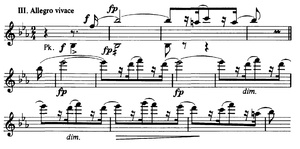3rd symphony (Dvořák)
The Symphony no. 3 in E flat major, Op. 10 is a symphony of the Bohemian composer Antonin Dvorak .
Emergence
The Third Symphony was written in 1872 and 1873, eight years after its two predecessors. A period in Dvořák's work in which the composer tried to combine romantic traits with the classical symphony. In this sense, the work was created during an experimental phase by the composer and is therefore probably the only symphony in Dvořák's oeuvre that consists of only three movements. Dvořák expanded the instrumentation to include harp and tuba . This line-up, some chromatic tendencies and the motifs are reminiscent of Richard Wagner in places .
To the music
occupation
2 flutes , piccolo , 2 oboes , English horn , 2 clarinets , 2 bassoons , 4 horns , 2 trumpets , 3 trombones , tuba , timpani , triangle , harp and strings
1st movement: Allegro moderato
The first movement begins with a motif which is reminiscent of the second main theme of the overture to Rienzi by Richard Wagner . The fourth motif, which characterizes both the introduction and the cantable main theme, is found in the form of motivic links throughout the symphony. It is processed extensively, repeated and then moved to minor. A second topic can hardly establish itself, which is why the sentence seems monothematic. This is very unusual for the concept of a symphony and also speaks for the experimental character of Dvořák at that time.
2nd movement: Adagio molto, tempo di marcia
The Adagio is a funeral march , unique for Dvořák's symphonic oeuvre . The movement shows great maturity and grandeur and can be seen as an early high point in Dvořák's work.
The sentence begins with an upward second , which seems like a sigh. The main theme is supported by three bangs, which are characteristic of the whole movement. The melody also changes slightly in a few short versions, but these are quickly ended by the mourning theme. This theme is repeatedly subjected to small variations, which, for example, provide varied accompaniments. About halfway through the long sentence there is a fundamental change. The march rhythm is retained in this middle section, but a new theme appears in major, the march is no longer a funeral march. The theme takes on almost jubilant features before the movement threatens to fall asleep, but after a short period of rest it starts again and leads to a tutti climax for the whole orchestra. Now Dvořák cleverly combines both themes and in this way comes back to the funeral march, which is heralded by the three bangs, but is now repeatedly interrupted by the major theme of the middle section. Ultimately, the major theme asserts itself and gives the sublime movement a peaceful and almost joyful conclusion.
3rd movement: Allegro vivace
In this symphony the usual scherzo is missing in the third position. The final movement follows the Adagio directly. This begins with a joyful and light theme in the strings initiated by the timpani. The sentence develops into a ceaseless movement under constant pressure. A second theme, performed by the piccolo , appears and mixes with the swirl of increasing cheer. Until the last chord, the movement is constantly moving and optimistically striding towards the end. Here he represents a great contrast to the previous funeral march.
effect
The first performance of the symphony took place on March 29, 1874 in Prague under the direction of Bedřich Smetana . He added the third movement from Dvořák's 4th Symphony to the performance in order to be able to perform a complete four-movement symphony. Dvořák subjected the work to a thorough revision in 1887, which led to some changes and resulted in the form of the work known to us today. The symphony was only printed after Dvořák's death in 1912.
The 3rd symphony plays an important role on Dvořák's path to an individual and mature musical language. A clear further development of the compositional style compared to the 1st and 2nd symphonies can be felt. The following symphonies consistently continued this path to mastery. Today the 3rd symphony is heard relatively rarely in the concert hall, although its importance should not be underestimated.
supporting documents
- Gottfried Eberle in: Lexicon Orchestermusik Romantik , ed. von Wulf Konold, Munich: Piper 1989, Vol. 1, pp. 190-192
- Christoph Hahn, Siegmar Hohl (eds.), Bertelsmann Konzertführer , Bertelsmann Lexikon Verlag, Gütersloh / Munich 1993, ISBN 3-570-10519-9
- Harenberg concert guide , Harenberg Kommunikation, Dortmund, 1998, ISBN 3-611-00535-5
Web links
- 3rd Symphony (Dvořák) : Sheet music and audio files in the International Music Score Library Project




